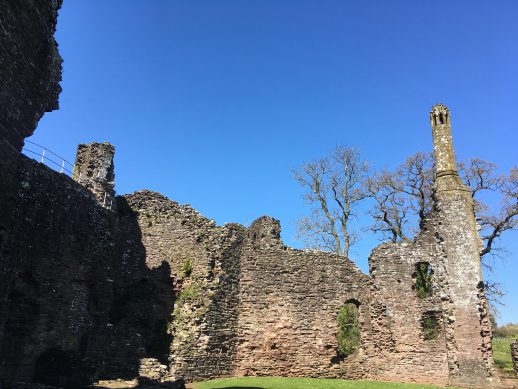Words and pictures: Jude Rogers
The strip of water that divides the two countries in which I have lived my whole life, at this moment in time, is the River Monnow. At the bottom of the long twisting lane that leads me down from our house to the slow lights on the border, it puddles by; a gentle, easy, brown thing, barely noticed by the cars roaring on amber, racing greenly on go. The bridge that joins the nations together is single-track, small, barely recognising the boundary. Here is England, here is Wales; the road continues gently, unremarkably, as it has done for centuries.
A mile up the river, uphill, is a castle, at Grosmont. This village name suggests swaggering Norman glamour, but it’s actually a Welsh word given two round English vowels. (Grysmwnt means “grey hill”; trust the Welsh to go for drabness over grandness.) It is a funny, characterful castle, as many Welsh castles are: tumbledown, but in many places remarkably preserved. A rickety walk up to a high wall holds hauntings of dark, dramatic pasts. The outline of a main hall in rugged stones and open mouths of what once were windows offer perfect places for hide-and-seek, both in ancient times of war, and on weekend afternoons when the sun and the toddlers are out.
In many ways, this castle was barely Welsh in its foundational years. Grosmont’s fortress-like form was decided by a man born in Surrey, Hubert De Burgh (he was in charge of running England at the time, as the country’s king, Henry III, was barely a teenager). In the 1300s, it was lived in and extended by English nobility, and it has a curious, octagonal tower to show for it, a glitzy beacon from a fancier age. By 1405, the Welsh revolt was somewhat undermining this gentility, but an English soldier stopped the incoming rebels at what became known as the battle of Grosmont. It turned out he was very good at commanding his men unto the breach. He became Henry V. He took Agincourt a decade later.
The son of the last Welsh Prince of Wales, Owain Glyndwr, was at the battle of Grosmont as well: Gruffudd died two years later in the Tower of London, and if that wasn’t bad enough, it was because he had bubonic plague. His father, the man who revolted famously — if unsuccessfully — for decades against English rule, disappeared around the same time, and his location from then on remained a mystery. Large rewards for his head went unclaimed. Royal pardons later offered to him went ignored. It is thought now that Glyndwr died at Kentchurch, just over the border in England, his daughter Alys being married to a man that lived there, John Scudamore. This Englishman had once fought him. Now he harboured him.
The Scudamores still live at Kentchurch today, at the other side of the puddling, gentle, easy Monnow. If I look out of my window, I can see the hills of Wales rising straightforwardly, and beautifully, into that village, into the fields of our close neighbours, into the fields of England. It is one view that I see, and one place, and one moment in time, but it feels together, complete. It reminds me that borders are lines that can disappear. On days like this, and at times like this, it feels right to keep this in the mind, as well as the eye.
*
See previous Over The Border posts here.
